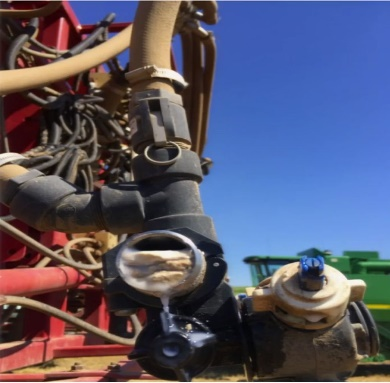With the wild spring and slow, wet, cool start to the growing season, many fields did not get the early-season residual herbicides they usually would. In many cases, this means a heavier reliance on postemergence herbicide programs. As we start to think about postemergence programs, it is important to remember the following guidelines:

Herbicide residue buildup at the end cap on a row crop sprayer that had not been properly cleaned for multiple times. Start clean; stay clean.
- All pesticide labels are different. Applicators should carefully read each label before applying the product. While I know that I probably write these words in vain for many, I cannot overemphasize how important this is, especially for Enlist One, Enlist Duo, Engenia, FeXapan, and Xtendimax as the labels are more prescriptive and precise than many other labels on the market.
- Start clean; stay clean. While most will think of the weeds in the field when they first see this (and that is a good recommendation for weed management …), in this case I’m referring to the sprayer. Cleaning the sprayer before and after applications, particularly when going from one product to another, is critical to ensure that unintentional accidents do not occur. When thinking about the new 2,4-D- and dicamba-tolerant systems, it is even more imperative that you are thorough in cleaning all of the potential contamination sources.
- Use BIG droplets. Use as coarse a droplet as possible without compromising the efficacy of the product. If coverage is a concern, default to higher spray volumes (GPAs) instead of smaller droplet sizes. Keep in mind that for the new 2,4-D and dicamba products, there are specific nozzles, pressures, and even tank-mix partners (including adjuvants) stipulated for application.
- Watch the wind. The wind speed and direction are the most critical factors that should be considered for any application. As a general rule, when the wind speed doubles, there is a 700% increase in drift at 90 feet downwind. This general trend holds true if the wind goes from 5 to 10 mph or 10 to 20 mph. Many pesticide labels include information about the maximum wind speed for application and many cap at 10 or 15 mph. Know the product you are applying and the in-field conditions during application.
- Don’t get caught in an inversion. The feared, dreaded, and somewhat mystical temperature inversion is one of the most dangerous conditions for a pesticide applicator. There are numerous ways to check for an inversion, ranging from using apps and weather forecasting websites to setting off smoke. There are even devices you can buy to detect inversions. Use all methods possible to make sure you avoid these dangerous conditions. Once particles and/or vapors are entrapped in inversion layers, there is no telling where or how far the pesticide will go!
- Keep it low and drive it slow. Keep the boom height at the minimum required to get a good overlapping pattern, recognizing that the new dicamba products have a maximum boom height of 24 inches. If you have 30-inch nozzle spacings, this may not be a good sprayer to use for the new dicamba products. Driving at slower speeds will help keep the boom at an appropriate height. In general, we see that the faster the application is, the higher the boom height becomes. Keep driving speeds below 15 mph for applications of the new dicamba products.
- Build in a buffer. For some products, like the new dicamba products, buffers are required. Even when buffers are not required, make sure you take time to know what sensitive areas are around your application area and minimize exposure risks. Scouting the area around the application site before spraying is ALWAYS a good idea!
- Follow through! After the application is made, continue to monitor the field for whatever pest you are targeting. Escapes and pesticide application failures are the first steps toward resistance. Make sure your applications are successful!
While this is not a comprehensive list of things to consider, these checks can help ensure a good start to the mid-summer application season. With the late summer that we are experiencing this year, postemergence applications could be as difficult as ever and it is important to use good judgement and be proactive whenever possible. As we get later into the summer, the temperatures usually rise, making applications even more difficult.
There is one last rule of thumb: When in doubt, sit it out! Remember that every product that is labeled for a particular crop is not necessarily right for every acre. There are high risk situations where we may not want to take a chance spraying a particular product even if it is labeled for that crop and field.






Post a comment
Report Abusive Comment